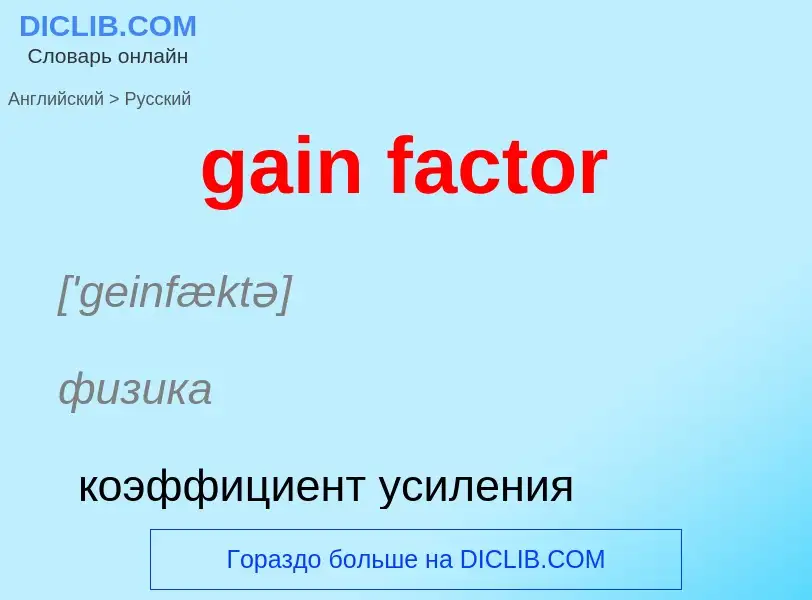Translation and analysis of words by ChatGPT artificial intelligence
On this page you can get a detailed analysis of a word or phrase, produced by the best artificial intelligence technology to date:
- how the word is used
- frequency of use
- it is used more often in oral or written speech
- word translation options
- usage examples (several phrases with translation)
- etymology
gain factor - translation to russian
['geinfæktə]
физика
коэффициент усиления
общая лексика
коэффициент усиления антенны
общая лексика
привес
Definition
Wikipedia

A fusion energy gain factor, usually expressed with the symbol Q, is the ratio of fusion power produced in a nuclear fusion reactor to the power required to maintain the plasma in steady state. The condition of Q = 1, when the power being released by the fusion reactions is equal to the required heating power, is referred to as breakeven, or in some sources, scientific breakeven.
The energy given off by the fusion reactions may be captured within the fuel, leading to self-heating. Most fusion reactions release at least some of their energy in a form that cannot be captured within the plasma, so a system at Q = 1 will cool without external heating. With typical fuels, self-heating in fusion reactors is not expected to match the external sources until at least Q ≈ 5. If Q increases past this point, increasing self-heating eventually removes the need for external heating. At this point the reaction becomes self-sustaining, a condition called combustion, and is generally regarded as highly desirable for practical reactor designs. Ignition corresponds to infinite Q, in which case no energy input is required to start self sustaining fusion reactions in the plasma.
Over time, several related terms have entered the fusion lexicon. Energy that is not captured within the fuel can be captured externally to produce electricity. That electricity can be used to heat the plasma to operational temperatures. A system that is self-powered in this way is referred to as running at engineering breakeven. Operating above engineering breakeven, a machine would produce more electricity than it uses and could sell that excess. One that sells enough electricity to cover its operating costs is sometimes known as economic breakeven. Additionally, fusion fuels, especially tritium, are very expensive, so many experiments run on various test gasses like hydrogen or deuterium. A reactor running on these fuels that reaches the conditions for breakeven, if tritium was introduced, would be operating at breakeven, and this theoretical threshold is referred to as extrapolated breakeven.
In 2021, the record for Q was held by the National Ignition Facility in the US, at Q = (1.35 MW)/(1.9 MW) ≈ 0.70, first attained in August 2021. The highest record for extrapolated breakeven was posted by the JT-60 device, with Qext = 1.25, slightly besting JET's earlier 1.14. ITER was originally designed to reach ignition, but is currently designed to reach Q = 10, producing 500 MW of fusion power from 50 MW of injected thermal power.
On December 13, 2022, the United States Department of Energy announced that a gain factor greater than 1 was achieved by the National Ignition Facility at Lawrence Livermore National Laboratory in California using inertial confinement fusion, delivering 2.05 MJ to generate 3.15 MJ from the resulting fusion reaction. This is roughly equivalent to a gain factor Q = 1.54 and is the first time that a gain factor Q ≥ 1 has been achieved in the history of nuclear fusion, besides in thermonuclear weapons.



